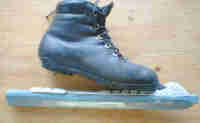
Cross-country skiers who are faced with a dearth of snow can switch to a workout on ice. By stepping onto speed-skate blades adapted for cross-country boots, skiers can practice their skiing technique while skating.
The Zandstra Ski Blade, made by a Dutch speed-skate manufacturer, is designed for mounting a cross-country binding to the skate. Zandstra has inserted 18-inch speed-skate blades into the underside of two hardwood platforms. By attaching a cross-country binding to the top of each platform, a skier can step out of his skis and onto his skates. The same cross-country boots work on both surfaces. The heel remains loose, as it does on cross country skis.
High Peaks Cyclery of Lake Placid, N.Y., imports the skate for United States distribution. Brian Delaney, owner of High Peaks, said recently that the skate gives athletes an alternate training method. ''You use the same muscles as in skiing,'' he said.
The Zandstra Ski Blade sells for $59.99 a pair. To order, telephone High Peaks at (800) 446-6472.
(Information is from a Dutch article, De geschiedenis van de langlauf- of Steinmetz-schaats (The History of the Cross-Country or Steinmetz Skate) by Anrie Broere in the skate collectors magazine Kouwe Drukte ,#29, April 2007, pg 8-12 )
( NEW Nordicskater now has an English translation of the original Steinmetz skate article )
The Zandstra ski-blades with wooden platforms were developed between 1987 and 1989 by Bert Steinmetz, a recreational skater from the Netherlands, whose ankles were not very strong. He recognized many advantages of attaching a cross-country (XC) ski binding to a skate blade, including:
However, the skating world was not ready for "free-heel" skates; the use of klap skates by racers didn't become common until 1997-98. Also, there was a lack of natural ice in the Netherlands, so sales were poor. North American sales were only slightly better.
But by 1995, several Swedish and Finnish companies were selling touring skates with free-heel (ie. XC ski) bindings mounted on aluminum platforms. Zandstra started selling aluminum platform skates about the same time. In 1997, another Dutch company, Free-Skate, began selling "higher-end" skates (with thinner blades of higher Rockwell rating steel), now including a "limited edition Classic" skate with a ash-wood base! - What is old is now new again!